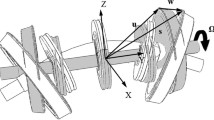Abstract
The flexibility of a train’s wheelset can have a large effect on vehicle–track dynamic responses in the medium to high frequency range. To investigate the effects of wheelset bending and axial deformation of the wheel web, a specific coupling of wheel–rail contact with a flexible wheelset is presented and integrated into a conventional vehicle–track dynamic system model. Both conventional and the proposed dynamic system models are used to carry out numerical analyses on the effects of wheelset bending and axial deformation of the wheel web on wheel–rail rolling contact behaviors. Excitations with various irregularities and speeds were considered. The irregularities included measured track irregularity and harmonic irregularities with two different wavelengths. The speeds ranged from 200 to 400 km/h. The results show that the proposed model can characterize the effects of flexible wheelset deformation on the wheel–rail rolling contact behavior very well.
Graphical Abstract
Wheelset flexibility has a significant effect on vehicle–track dynamic responses in the medium to high frequency range. To investigate the effects of wheelset bending and axial deformation of the wheel web, a specific coupling of wheel–rail contact with a flexible wheelset is presented and integrated into a conventional vehicle–track dynamic system model. Both the conventional and proposed dynamic system models are used to analyze the effect of the wheelset bending and the axial deformation of wheel web on the wheel–rail rolling contact behaviors.
















Similar content being viewed by others
References
Jin, X.S., Xiao, X.B., Ling, L., et al.: Study on safety boundary for highspeed train running in severe environments. J. Rail Transp. 1, 87–108 (2013)
Jin, X.S., Wen, Z.F., Wang, K.Y., et al.: Three-dimensional train–track for study of rail corrugation. J. Sound Vib. 293, 830–855 (2006)
Grassie, S., Kalousek, J.: Rail corrugation, characteristics, cause and treatments. Proc. Inst. Mech. Eng. F 207, 57–68 (1993)
Nielsen, J.C.O., Lundén, R., Johansson, A., et al.: Train–track interaction and mechanisms of irregular wear on wheel and rail surfaces. Veh. Syst. Dyn. 40, 3–54 (2003)
Nielsen, J.C.O., Ekberg, A., Lundén, R.: Influence of short-pitch wheel/rail corrugation on rolling contact fatigue of railway wheels. J. Rail Rapid Transit 219, 177–188 (2005)
Oostermeijer, K.H.: Review on short pitch rail corrugation studies. Wear 265, 1231–1237 (2008)
Chaar, N.: Wheelset structural flexibility and track flexibility in vehicle/track dynamic interaction, [Ph.D. Thesis], Royal Institute of Technology, Stockholm (2007)
Popp, K., Kruse, H., Kaiser, I.: Vehicle/track dynamics in the mid-frequency range. Veh. Syst. Dyn. 31, 423–463 (1999)
Szolc, T.: Medium frequency dynamic investigation of the railway wheelset–track system using a discrete–continuous model. Arch. Appl. Mech. 65, 30–45 (1998)
Szolc, T.: Simulation of bending-torsional-lateral vibrations of the railway wheelset–track system in the medium frequency range. Veh. Syst. Dyn. 30, 473–508 (1998)
Popp, K., Kaiser, I., Kruse, H.: System dynamics of railway vehicles and track. Arch. Appl. Mech. 72, 949–961 (2003)
Meinders, T.: Modeling of a railway wheelset as a rotating elastic multibody system. Mech. Dyn. Probl. 20, 209–219 (1998)
Baeza, L., Vila, P., Xie, G., et al.: Prediction of rail corrugation using a rotating flexible wheelset coupled with a flexible track model and a non-Hertzian/non-steady contact model. J. Sound Vib. 330, 4493–4507 (2011)
Torstensson, P.T., Pieringer, A., Nielsen, J.C.O.: Simulation of rail roughness growth on small radius curves using a non-Hertzian and non-steady wheel–rail contact model. In: Proceedings of the Ninth International Conference on Contact Mechanics and Wear of Rail/Wheel Systems, Chengdu, August (2012)
Torstensson, P.T., Nielsen, J.C.O.: Simulation of dynamic vehicle–track interaction on small radius curves. Veh. Syst. Dyn. 49, 1711–1732 (2011)
Andersson, C., Abrahamsson, T.: Simulation of interaction between a train in general motion and a track. Veh. Syst. Dyn. 38, 433–455 (2002)
Zhong, S.Q., Xiao, X.B., Wen, Z.F., et al.: The effect of first-order bending resonance of wheelset at high speed on wheel–rail contact behavior. Adv. Mech. Eng. 2013, 19 (2013). doi:10.1155/2013/296106
Zhong, S.Q., Xiao, X.B., Wen, Z.F., et al.: A new wheel–rail contact model integrated into a coupled vehicle–track system model considering wheelset bending. In: Pombo, J. (ed.) Proceedings of the Second International Conference on Railway Technology Research, Development and Maintenance, 2014. Paper 10. Civil-Comp Press, Stirlingshire
Wang, K.W.: Wheel contact point trace line and wheel/rail contact geometry parameters computation. J. Southwest Jiaotong Univ. 1, 89–99 (1984)
Xiao, X.B., Jin, X.S., Wen, Z.F., et al.: Effect of tangent track buckle on vehicle derailment. Multibody Syst. Dyn. 25, 1–41 (2011)
Shen, Z.Y., Hedrick, J.K., Elkins, J.A.: A comparison of alternative creep force models for rail vehicle dynamic analysis. In: Proceedings of the Eighth IAVSD Symposium, 591–605. MIT, Cambridge (1983)
Zhai, W.M.: Vehicle/Track Coupling Dynamics, 3rd edn. Chinese Science Press, Beijing (2007)
Zhong, S.Q., Xiong, J.Y., Xiao, X.B., et al.: Effect of the first two wheelset bending modes on wheel–rail contact behavior. J. Zhejiang Univ. Sci. A 15, 984–1001 (2014)
Acknowledgments
The present work was supported by the National Basic Research Program of China (Grant 2011CB711103), the National Natural Science Foundation of China (Grants U1134202, U1361117), the Program for Changjiang Scholars and Innovative Research Team in University (IRT1178), the 2014 Doctoral Innovation Funds of Southwest Jiaotong University, and the Fundamental Research Funds for the Central Universities.
Author information
Authors and Affiliations
Corresponding author
Rights and permissions
About this article
Cite this article
Zhong, S., Xiao, X., Wen, Z. et al. Effect of wheelset flexibility on wheel–rail contact behavior and a specific coupling of wheel–rail contact to flexible wheelset. Acta Mech. Sin. 32, 252–264 (2016). https://doi.org/10.1007/s10409-015-0441-6
Received:
Revised:
Accepted:
Published:
Issue Date:
DOI: https://doi.org/10.1007/s10409-015-0441-6




